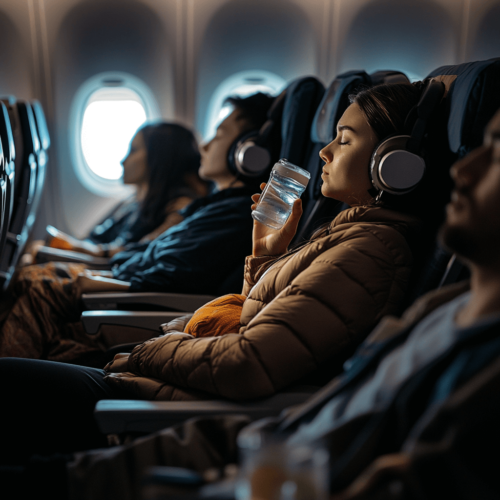Air travel and visiting new destinations is exciting but long-haul flights, those longer than six hours or 3,000 miles, can take a toll on your body. Hours of sitting in a pressurized cabin with low humidity can lead to dehydration, joint stiffness, and even more serious conditions like deep vein thrombosis (DVT). At Alliance Chiropractic, we want to help our patients make the most of their travel adventures, and that includes special consideration for long-haul flights. Read on for tips to help you feel your best during and after your flight.
How Long-Haul Flights can Affect Your Body
During a long flight, specific cabin conditions and limited opportunity for physical movement may result in your body experiencing the following:
- Dehydration: The low humidity in airplane cabins can lead to dry skin, headaches, and fatigue.
- Joint and Muscle Stiffness: Prolonged sitting can make muscles and joints stiff, leading to discomfort and potential pain.
- Circulation Issues: Long periods of sitting may slow blood flow, increasing the risk of DVT, a condition where blood clots form in the legs.
- Swelling: Changes in cabin pressure and immobility can cause fluid retention, leading to swollen feet and ankles.
- Sleep Disruption: Bright cabin lights, noise, and cramped spaces can make it difficult to rest, leaving you fatigued upon arrival.
Tips for a Healthy and Comfortable Flight
1. Layer Up
Cabin temperatures fluctuate, so dressing in layers allows you to stay warm or cool as needed.
- Tip: Wear loose-fitting clothing for comfort and opt for breathable fabrics if possible. Bring a lightweight jacket or cardigan which can also serve as a blanket or pillow, if needed.
2. Stay Hydrated
Dehydration is a common issue during long flights. Avoid it by:
- Bringing a reusable water bottle to fill after passing security
- Avoiding diuretics like alcohol and caffeine
- Using a moisturizer and lip balm to keep your skin hydrated
Tip: Staying hydrated is also vital for preventing pain.
3. Get Up and Move
Sitting for hours can slow blood flow and increase the risk of DVT. To improve circulation:
- Walk the aisles when it is safe to do so
- Stretch your legs, ankles, and feet while seated
- Consider wearing compression socks to support healthy blood flow
4. Pack Like a Travel Pro
Having specific items on hand can help make your flight more enjoyable, and avoid unnecessary costs:
- Travel Essentials: A neck pillow, eye mask, noise-canceling headphones, and a small toiletry kit are all available in travel sizes and can enhance flight comfort
- Healthy Snacks: Bring nutrient-dense options like nuts, granola bars, or dried fruit incase there are flight delays or airline food is not to your liking
- Bring Activities: Pre-download movies, music, or books for entertainment and to combat boredom
5. Manage Stress and Sleep
Resting on a long flight can be challenging but it is possible:
- Use a travel pillow and noise-canceling headphones to create a peaceful environment
- Adjust your watch to your destination’s time zone to start adapting your sleep schedule mid-flight
- Practice mindfulness or deep breathing exercises to reduce stress
Protect Your Back During Travel
Back pain is a common complaint after long-haul flights, especially for those who struggle with posture or heavy luggage.
- Lift Carefully: Avoid overextending your back when handling luggage (think vehicles, baggage check-in systems, luggage carousels, overhead plane compartments, etc.)
- Mind Your Posture: Sit with your back straight and feet flat on the floor whenever possible
- Stretch Often: Periodic stretching helps to break up long periods of immobility, and can include simple stretches such as rolling your shoulders or gently twisting your torso
We can help! Ask us if you have questions or need some guidance on effective in-plane exercises.
Tip: For more ways to protect your back, check out our recent blog, 5 Tips to Avoid Back Pain While Traveling.
Fly Smarter, Feel Better
Following these tips can minimize the physical effects of long-haul flights and ensure you arrive at your destination, refreshed and ready to go. Dress comfortably, stay hydrated, move regularly, and bring a few essentials to help make your journey enjoyable.
Alliance Chiropractic is dedicated to supporting your health and wellness. While our focus remains your musculoskeletal system, we are committed to providing you with information to help inform and educate you on other factors that could affect your health. If we don’t have the answers, our team will do our best to help you find the resources that do.
Contact us if you have questions regarding this blog or any other health or wellness concern.
Want to stay updated on health information? Subscribe to our quarterly newsletter.
Information for this blog was sourced from our previous blog, AARP, and National Geographic.

